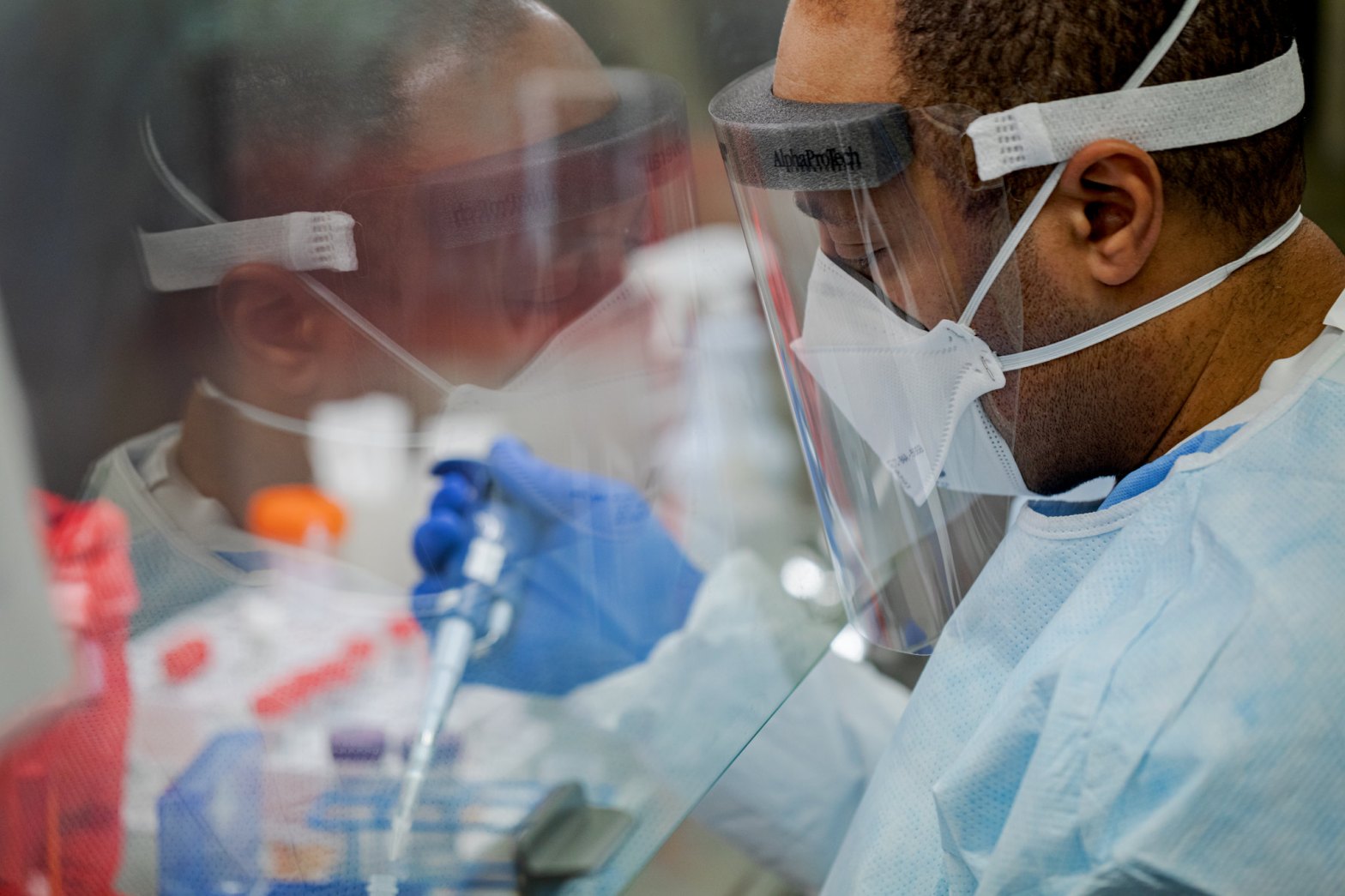This article was adapted for the U.S. context from www.socialistworld.net. The original was written by Martin Powell-Davies.
As COVID-19 continues to claim lives and ravage communities, President Trump is exerting increasing pressure on states to “reopen for business.” The economic impacts of the shut-down have undoubtedly been devastating for laid-off workers and shuttered small businesses. But rushing to resume business as usual before the epidemic is sufficiently controlled will result in more deaths, increased pressure on our already overburdened healthcare system, and possibly a second major spike in the illness. Even as Trump (incorrectly) claims that new COVID-19 cases are on the decline and accuses Democratic governors of being too slow to reopen their states, the White House is experiencing a COVID-19 outbreak.
There is a growing scientific consensus that successful management of the COVID-19 crisis requires a comprehensive plan—combining mass testing, contact tracing, and supported isolation of potentially infected individuals. But under our chaotic capitalist system, such a well-managed plan is proving unachievable.
Medical science was already well aware that contact tracing has to be a key part of any strategy to tackle a viral epidemic, particularly where no vaccine is yet available. It is a technique already proven to work when tackling Ebola, SARS, and MERS, for example.
The strategy is simple enough to understand. If you can quickly identify the close contacts of someone who is found to be infected, and then make sure that all these individuals are safely isolated, the onward transmission of the virus is hopefully prevented. If this is done consistently, most new cases can be identified, isolated, and the outbreak eventually brought under control, avoiding further peaks of new infections.
Of course, what works medically has a social and economic cost too. Who pays to look after the income and welfare of the isolated individuals and their dependents for what, in the case of COVID-19, might need to be at least 14 days in isolation?
Their jobs and income must be guaranteed, or the strategy will fail to operate successfully. Similarly, resources have to be in place for food deliveries and other practical support to those who need it in order to remain isolated.
Contact tracing and mass testing needed
How is contact tracing itself going to be carried out? Commentators place hopes in the development of tracing apps that could use smartphones to alert people that they have potentially been infected by someone who has been close to them.
But, even if they prove reliable, many, particularly the oldest and worst-off, may not own the kind of phones needed. Fears about privacy will also need to be addressed for take-up to be sufficiently high. Around 60% of the population and 80% of smartphone owners will need to use these apps for such a system to work.
These apps represent a new billion dollar industry for hugely wealthy tech companies like Google and Amazon. These private companies looking to profit off of the pandemic will put profit before people and privacy.
In addition to these apps, mass recruitment of contact tracers is going to be needed. Some of the work can be done remotely through phone interviews, some may require direct visits with adequate personal protective equipment (PPE). This will create a new layer of workers who are on the frontlines of the pandemic.
It’s clear that setting up a contact tracing system in the U.S. will not only necessitate a centralized approach, but also a huge amount of resources. Right now, the government has not publicized any sort of contact tracing plan for re-opening. Instead, states are taking it upon themselves to decide whether they want to put the necessary resources into contact tracing programs. In Minnesota, for example, the state legislature is in a battle over increasing their contact tracing team from a few dozen to four thousand. Even this increased number will not be enough to properly implement contact tracing.
Taking a state-by-state approach will undercut the effectiveness of national contact tracing. States that don’t prioritize contact tracing will undoubtedly have higher cases of COVID-19 after they reopen, putting workers in that state and neighboring states at a higher risk.
For a disease like COVID-19, where some proportion of infections seem to be passed on from people without obvious symptoms, mass testing is vital. We need testing properly integrated into an overall strategy, firstly to identify individuals who have the virus, and then to test their traced close contacts. This will take significant national resources.
Unfortunately, Trump and his government of capitalists have already shown that they care more about keeping the rich happy. They bailed out huge oil companies and the capitalist class while leaving us in financial peril. Despite Trump’s claims at the beginning of this crisis that there would be enough tests, there are still not enough.
If testing could be done in sufficient numbers, and with sufficiently reliable tests, this could alleviate some of the isolation requirements. It might also identify more individuals who actually need hospitalization rather than just isolation.
Given the nature of the virus and uncertainty over immunity, testing will need to be regularly repeated, not just a one-off. It will also require much faster results—turnaround times can reportedly be as fast as six hours, but backlogs mean processing times of several days. All of this demands an increase in capacity, certainly far greater than states are prepared to give.
Of course, identifying carriers and contacts quickly is one thing. Ensuring they then isolate themselves is another. Without widespread access to paid sick leave, guaranteed jobs and housing security, and support services like free grocery delivery, self-isolation will be impossible for many in the U.S.
No “quick fix”
There is no “quick fix” to this crisis. For contact tracing to work, employers need to understand that some of their workforce may receive a message that they need to quickly isolate themselves. Workers need to be assured they can do so without losing income, their jobs, housing, or health coverage—even if they need to self-isolate multiple times over the course of the epidemic.
If, as in the case of retail, healthcare, transportation, construction, and so many other sectors, work is being carried out without adequate social distancing and PPE, the risk of being a close contact of an infected person increases significantly.
Where possible, workplaces must close to allow for deep cleans after confirmed cases. Where, as in schools, consistent physical distancing is hard to guarantee, remaining closed altogether may even be necessary. In workplaces where this cannot happen, PPE, staggered usage, hygiene provisions, and other protocols are doubly important.
Another problem is that it is unclear exactly how accurate COVID-19 tests are, because this is a new disease. Early research in China—unconfirmed as yet—suggests the most common test could give false negatives up to 30% of the time. So workers must have a negative test and be symptom-free before returning to work.
On top of this, the current guidelines state that if you live with someone experiencing symptoms, you should self-isolate for 14 days. This does not extend to working with someone experiencing symptoms—but we say it must.
Workers with underlying conditions and those in high-risk groups should also continue to stay at home and be given full pay. The guidelines for who is at a high-risk may need to be expanded. For example, the government guidance on at-risk age groups begins at 65, but the data indicate it should begin at 60.
Safety vs. profits
A socialist government would have been in a far stronger position to manage this. Nationalization of the healthcare, pharmaceutical, and medical supply sectors, as well as big business generally, under the democratic control and management of workers, would allow a rapid and thorough democratic plan of emergency production and distribution.
Bluntly, unless workplace safety is put ahead of short-term profits, the outbreak cannot be properly managed. If the employers won’t guarantee it—and experience shows they will not voluntarily—labor unions must assert control over safety with elected workplace health and safety committees.
Of course, if these necessary measures had been carried out earlier, then it wouldn’t now be so difficult to repair the damage. And a premature reopening of the economy before necessary measures are in place will likely exacerbate the problem.
In reality, the evidence from China and other countries that had already been battling the infection already showed what was needed. There, early application of contact tracing and testing was used to isolate the outbreak to more manageable hotspots. Here, the Trump administration delay means it will take a lot longer for a similar strategy to work. However, it is the only realistic approach to ending the lockdown safely.
Image credit: Tom Wolf / Flickr

